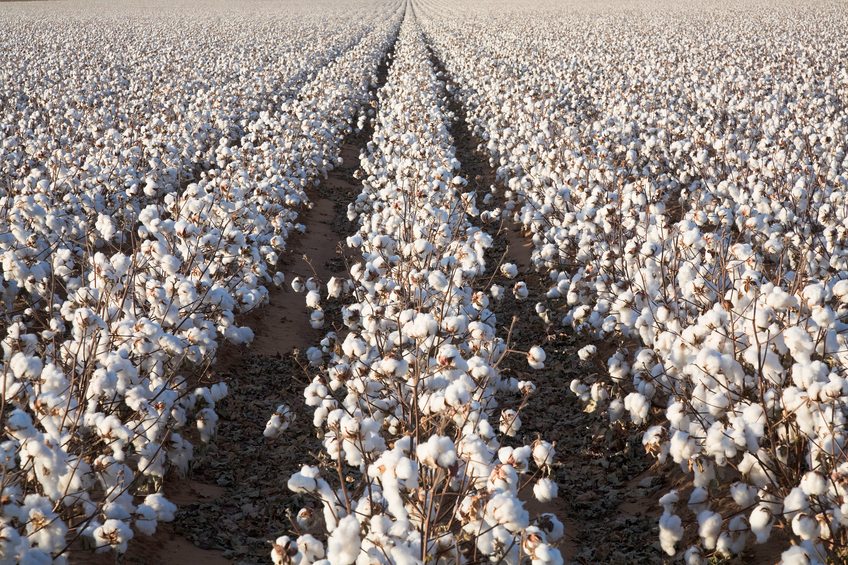Rain kept farmers from touring the test plots at the new Bayer CropScience Cotton Breeding Station in Lubbock, Texas, Sept. 28. But it didn’t dampen enthusiasm for the new $16.7 million state-of-the-art facility and what it means for West Texas cotton farmers.
Farmers gathered for the annual Showcase Plot Tour and heard from Bayer officials about cotton varieties and other research in the pipeline. They also toured the new facility and learned about the new technologies that are bringing science to their fields more efficiently.
Cory Mills, Bayer CropScience cotton breeder, explained to growers that the new facility brings plant breeding and trait development into one campus, while still segregating them per regulations. This means breeders and scientists can improve communication across channels and improve their working relationships.
The breeding objectives remain the same, though, he added. First, finding better varieties that can withstand drought and on the other end of the spectrum finding varieties that will perform under full irrigation. Dryland or limited irrigation acres are predominant in the area, Mills said, therefore its critical to use a nursery environment that mimics that stress so that breeders can make better selection decisions.
Russ Perkins, senior technical service representative for Bayer then spoke about work on weed control that’s being conducted out at the new station. He advised growers to consider seed treatments and weed control methods to protect the potential of the seeds they’re planting.
“Growing cotton is in your genes,” Perkins says. “Higher fiber quality is in our genetics.” It’s only logical to protect those genetics to give the cotton the best early season advantages possible to make a high quality harvest, he adds.
Perkins reviewed the Bayer crop protection portfolio and reminded growers to use the S.T.O.P. method in controlling glyphosate resistance in their fields while using the company’s Liberty system.
Start early. Using yellow preplant burndown chemicals to keep a field as clean as possible.
Target weeds at 3 inches or shorter. “The easiest weed to control is one that never sees the light of day,” he says. But a pigweed can grow up to 1.5 inches per day and farmers need to be ready to spray before the pigweeds get away from them.
Optimize coverage. That means using the right rate, the right water volume, the right droplet size to cover the plants, he said.
Pair with residuals and multiple modes of action. It’s not enough to start clean; farmers need to put residual chemicals down right after the planter so they can control the next flush of weeds as they challenge the crop. “When you put residuals out you are building a blanket of protection until the cotton is mid-bloom and the canopy closes,” Perkins says.
Perkins also talked to growers about harvest aid trials at the station and the timing of applying harvest aids to cotton.
“We recommend applying harvest aids at about 60 percent open bolls,” Perkins says. “But people often wait until the field is about 90 percent open boll.” When you look at the cotton plant and where the money bolls are located, he explained, the four to five nodes above cracked boll make the most money on the plant. If you wait until all the bolls are cracked, trying to eke out just a few more open bolls, you actually can lose money by diminishing the quality of the bolls that are open early and provide the better return.
“Manage your money bolls,” he says. “Let the harvest aid crack the top and focus on the lower bolls.”
Change is coming
Bayer CropScience’s planned acquisition of Monsanto is still in the works. On Oct. 13, BASF announced it agreed to acquire significant parts of Bayer’s seed and non-selective herbicide businesses. This is part of Bayer’s work to divest some assets before its acquisition of Monsanto.
Bayer’s Liberty, Basta and Finale brands of glufosinate-ammonium non-selective herbicides will sell to BASF, as well as its cottonseed businesses in the Americas and Europe. Bayer will also sell its trait research and breeding capabilities for these crops as well as the LibertyLink trait and trademark. Also in this transaction will be Bayer’s InVigor brand canola hybrids in North America with LibertyLink trait technology; its oilseed rape in European markets; and its soybean seed business in the Americas.
For the full year 2016, sales of the business to be purchased from Bayer are about 1.3 billion Euros. The transaction is subject to the closing of Bayer’s acquisition of Monsanto and approval by relevant authorities. It is expected to close in the first quarter of 2018.
More than 1,800 commercial, research and development, breeding and production personnel will transfer from Bayer to BASF. These employees are primarily located in the United States, Germany, Brazil, Canada and Belgium. Furthermore, BASF will acquire the manufacturing sites for glufosinate-ammonium production and formulation in Germany, the U.S., and Canada, seed breeding facilities in the Americas and Europe as well as trait research facilities in the U.S. and Europe.
Source: High Plains Journal, Jennifer M. Latzke












